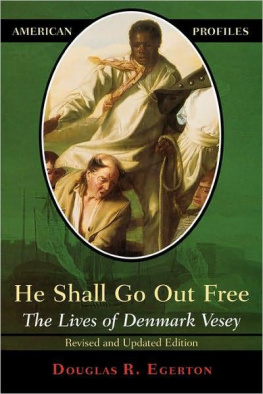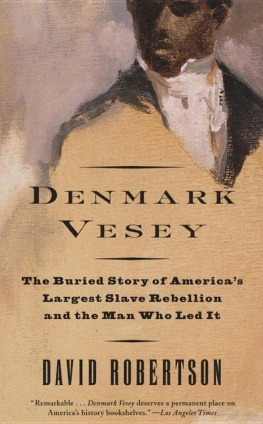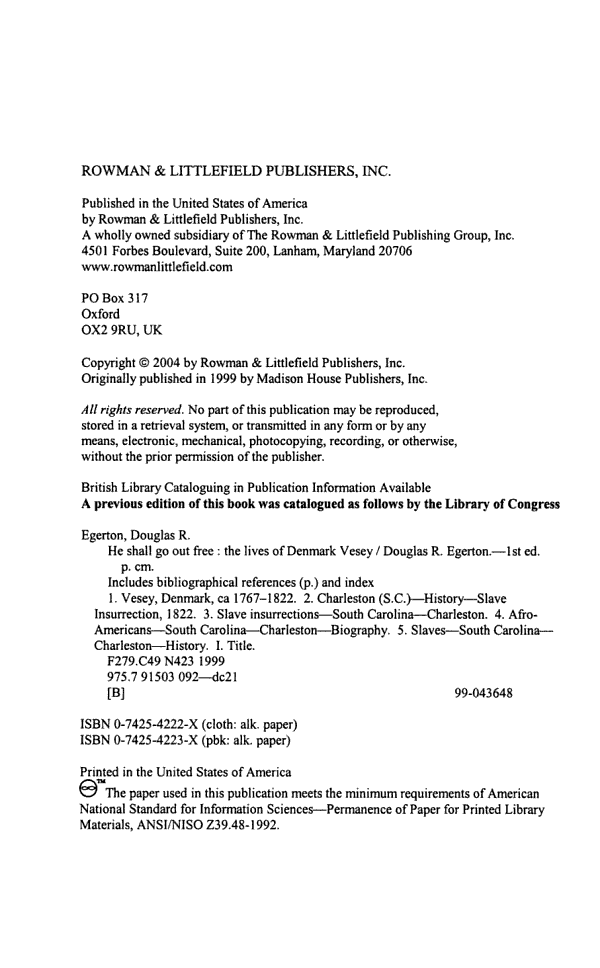Copyrighted image removed by Publisher
He Shall Go Out Free
The Lives of Denmark Vesey
Revised and Updated Edition
Douglas R. Egerton
He Shall Go Out Free
Copyrighted image removed by Publisher
He Shall Go Out Free
The Lives of Denmark Vesey
Revised and Updated Edition
Douglas R. Egerton
For Kearney and Hannah
American Profiles
Norman K. Risjord, Series Editor
Thomas Jefferson
By Norman K. Risjord
Mary Boykin Chesnut: A Confederate Womans Life
By Mary A. DeCredico
John Quincy Adams
By Lynn Hudson Parsons
He Shall Go Out Free: The Lives of Denmark Vesey
By Douglas R. Egerton
Samuel Adams: Americas Revolutionary Politician
By John K. Alexander
Jeffersons America, 1760-1815: Second Edition
By Norman K. Risjord
Martin Van Buren and the Emergence of American Popular Politics
By Joel H. Silbey
He Shall Go Out Free: The Lives of Denmark Vesey, Revised and Updated Edition
By Douglas R. Egerton
Illustrations
Map of the Caribbean, 1781 12
A View of Charles-Town by Thomas Leitch 30-31
Free Black and Slave Identification Tags 63
Map of Charleston, 1822 84-85
Percentage of Slaves in Total Population, 1830 129
Jean-Pierre Boyer, President of Haiti 137
Map of the South Carolina Coastline, 1821 141
Charleston Workhouse and City Jail 201
Title Page of An Official Report of the Trials of Sundry Negroes 207
Editors foreword
THE COMPLAINT OF MANY PEOPLE who dislike history is that it is full of obscure names, arcane dates, and big words that always seem to end in ism. The problem is that history, in some ways, is like a foreign language. The grammar has to be mastered before thought, discussion, and interpretation is possible. The task confronting the teacher of history is how to sugarcoat the pill.
For some years I have given a talk to educators at meetings and seminars around the country entitled Making History Human. It is essentially a pitch for a biographical approach as a pedagogical device. I am not advocating the reduction of history to a series of human-interest stories. My thesis, instead, is that complex and often dry subjects (when presented in general terms) can be enlivened and given meaning through a focus on one of the individual stories. For example, P. T. Barnums impact on popular amusements can add a new dimension to the concept of democracy in nineteenth-century America. The story of Jackie Robinson can add poignancy to the often legalistic (because of its emphasis on statutes and court decisions) story of civil rights in the middle decades of the twentieth century.
That is the basic purpose of Madison Houses American Profiles seriesto add a human dimension to the study of history. American Profiles offers relatively concise and swiftly-paced sketches that contribute significantly to the discourse on the American past. Each narrative takes advantage of the explosion of recent historiography while the authors interpretive insights serve as a basis for organizing that mass of complex and often disparate information.
What we hope to do with the books in the American Profiles series is to tell the American storyto tell the multitude of our national stories. Our goal is to arouse interest and provoke thought. Once that is accomplished, we can truly begin to teach our history.
Norman K. Risjord
Series Editor
Acknowledgments
THE MOST ENJOYABLE PART of writing a book is thanking those friends and colleagues who helped make the long, solitary journey a pleasure. Kimberly Hanger, Peter P. Hinks, Norrece T. Jones, Mitchell Snay, Margaret Washington, and Donald R. Wright all read parts of the manuscript and made invaluable suggestions which is not to say I always had the wit to follow their sage advice. Edward Pearson graciously allowed me an advance look at the length introduction to his collection of Vesey trial documents, and I have enjoyed our ongoing conversations about which actor should best play the role of Vesey in the big-budget film we both fantasize about.
At the South Carolina Department of Archives and History, Columbia, Charles Lesser kindly pointed me in the direction of several important collections I would otherwise have missed, and Wylma Wates shared with me her research on what is generally, but evidently wrongly, believed to be Veseys Bull Street house. Stephen C. Crane corrected some of my errors regarding Vesey family genealogy. Robert Paquette shared the fruits of his Cuban research with me, and Svend Holsoe provided me with several Haitian newspapers pertinent to Veseys youth. Daniel L. Schafer furnished me with dates critical in piecing together Jack Pritchards arrival in Charleston. Special thanks also to Connie and Carl Schultz, whose kind hospitality made my time spent in Columbia a pleasure.
Most of this project was funded by a generous grant from Le Moyne Colleges Committee on Research and Development, for which I am extremely grateful. Chapter 5, in a somewhat different form, appeared in the South Carolina Historical Magazine, and parts of Appendix II appeared in the William and Mary Quarterly. At Madison House, series editor Norman K. Risjord did a superb job editing the manuscript, and Gregory M. Britton proved unusually patient with my many whims and chronic lateness. John P. Kaminski and Kevin Morrissey also deserve thanks for their support and kind attention to detail. As always, John Langdon cheerfully read the galleys with unusual speed and skill.
For the second edition, I wish to also thank Catherine Clinton, Allison Dorsey, Stanley Harrold, Peter Kolchin, Charles Lesser, Monique Patenaude, Bernard Powers, Markus Rediker, and Peter Wood. I am particularly indebted to Alison Games, who read the book with enormous insight and care and lived up to her formidable reputation as an enemy of the unnecessary comma and hyphen. Laura Gottlieb of Rowman and Littlefield first suggested the idea of a second edition and saw it through production with speed and precision.
I am especially grateful to Alan Gallay and Graham Russell Hodges, who read and reread every page; their advice, support, and friendship is worth more than I can say. Marcus Rediker weighed in at a critical moment with good words of advice and encouragement. My best and toughest critic, Linda Egerton, read the entire manuscript and bluntly told me what chapters worked and what chapters needed to be tossed out and redone. Her love and patience, however, far more than her editorial ability, made this study possible.
This book is dedicated to my daughters Kearney and Hannah, who slowed its completion down by a good year, at the very least, and in the process made every moment of my life an absolute joy.
D. R. E.
Fayetteville, New York
May, 2004
Introduction
THE ART OF BIOGRAPHY is deceptively simple. Even when the subject proves a willing participant by leaving behind diaries and letters and autobiographies, there is little guarantee that the biographer can accurately recover the past. (Some people deceive themselves and their diaries as easily as they deceive others.) The biographer has to explain not just the what and the when of history, but also the why; the practitioner of this art must spend years of reading and research learning not just to walk in the subjects shoes, but to creep into the subjects consciousness as well.







